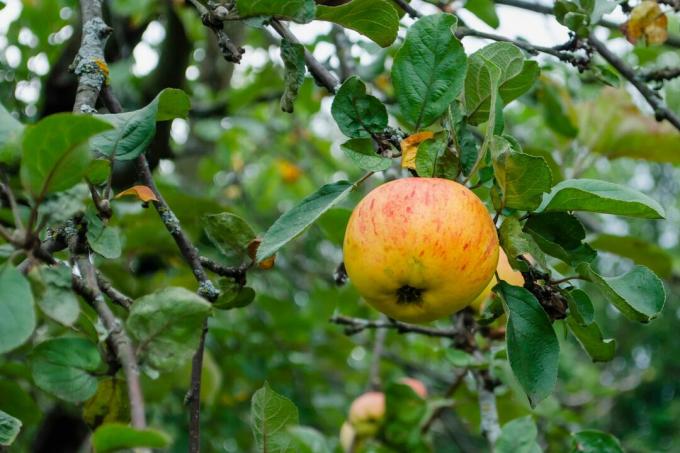How does the Korbinian apple taste? When is the apple ripe? And what is the story behind the variety? In this article you will find all information about the apple variety ‘Korbiniansapfel’.

The apple variety ‘Korbiniansapfel’ (Malus domestica ‘Korbiniansapfel’) is not an everyday variety and does not come from an idyllic breeding garden or from a horticultural research institute. We tell you about the special history, the robust properties and the excellent taste of the Korbinians apple.
contents
- Korbiniansapfel: Wanted poster
- Origin and history
- Apple variety ‘Korbiniansapfel’: taste and properties
- Special features in cultivation & care
- Korbinian apple: harvest & use
Korbiniansapfel: Wanted poster
| Synonyms | 'KZ 3' |
| fruit | medium-sized; golden yellow basic color with red stripes |
| taste | juicy, aromatic, sweet and sour, light vanilla aroma |
| Yield | regularly; occurring medium early |
| Harvest time | from the end of October |
| Ripe for enjoyment | since December |
| Shelf life | very good; storable until April / May |
| growth | strong |
| climate | low demand; Can be grown up to medium altitudes |
| Diseases and pests | robust against diseases and pests |
Origin and history
The Korbinians apple had another name until 1985: KZ-3. The reason for this is the eventful breeding history of the apple, which was bred in the Dachau concentration camp by the Bavarian pastor and pomologist (apple scientist) Korbinian Aigner.
The also as Apple priest Well-known Korbinian Aigner was not only enthusiastic about his priestly duties, but also about agriculture - especially apple cultivation - and political issues. After hearing a speech by the aspiring Adolf Hitler, he began to focus on his sermons and the Religious instruction in his community Hohenbercha actively against the ideas of National Socialism to pronounce. He was betrayed and taken to the Dachau concentration camp. There he was mainly used in agricultural activities and even made it under the most adverse Conditions to grow 4 promising apple varieties through a seedling selection: He named them KZ-1, KZ-2, KZ-3 and KZ-4. Only KZ-3 survived to this day and was in 1985 in honor of Korbinian Aigner in the Korbinian apple renamed. Of the Apple priest Incidentally, survived the concentration camp, returned to his home town of Hohenbercha and was then member and later state chairman of the Bavarian regional association for fruit and vegetables for many years Horticulture.
Apple variety ‘Korbiniansapfel’: taste and properties
The Korbiniansapfel is a medium-sized, rounded apple with 5 pronounced ribs, i.e. bulges for each carpel. The fruit skin is smooth and the basic color is greenish-yellow on the shaded side, later yellow and finally golden-yellow with strong red stripes. With good exposure, the whole fruit can also be reddened. The peel produces a lot of vegetable fatty acids and wax (cuticula), so that the apple has a greasy shine.
The pulp is fine-celled, firm and juicy. The taste of the corbinian apple is aromatic and equally sweet and sour if the growing conditions are right. When fully ripe, a light vanilla aroma should be tasted.

Special features in cultivation & care
Overall, the Korbinians apple is considered to be robust and resilient. As a rule, it successfully fends off diseases and pests. It prefers clay soils because, like all apple trees, it rewards a good water supply and nutrient availability with good health and high quality fruits. Because the Korbinian apple grows vigorously and for this reason does not stay small, it is particularly well suited for orchards and cultivation in the open field. It quickly forms a broad, spherical crown with strong framework branches and many branches. With a poorly growing base, however, it can also find space in a spacious home garden if there is enough space for it.
Korbinian apple: harvest & use
Depending on the weather and the cultivation location, the harvest of the ripe apples can begin in late October or in November. The fruits that are harvested not quite ripe can be kept for a very long time in good conditions because of their natural protective layer of cutin and wax store: In a cool natural storage until March, in a cold, dark, sufficiently moist and ventilated earth cellar or storage even into the May. If the humidity in the warehouse is high enough, the fruits hardly wilt.
The Korbiniansapfel is very suitable as a dessert fruit for snacking, in muesli or also for cooking.
Like all apple trees, the corbinian apple is dependent on insects as pollinators. So without the help of bees and bumblebees, you would not be able to harvest any fruit from this particular tree. Would you like to return the favor to the hard-working helpers in return by offering them a livelihood even after the apple blossom? Then find out how to get one Nesting aid for wild bees builds or like one Bee pasture supports the nutrition and reproduction of these and other insects.

